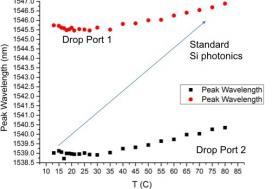Resistance To Temperature Swings Promises to Reduce the Cost of Maintaining Photonic Chips
Silicon photonic chips that can withstand dramatic temperature swings without interfering with their operation were developed by scientists working with the Center for Integrated Access Networks (CIAN), an NSF-funded Engineering Research Center (ERC) that is based at the University of Arizona.
Temperature sensitivity remains a major limitation of silicon photonic chips, which use lasers to rapidly transmit local data much like fiber optics speed data across long distances. The “athermal” chips developed at CIAN promise to reduce the power-hungry and costly systems required for precise temperature control in network devices.
The chips with integrated photonics technology promise to overcome the bottleneck created by much slower copper in storage area networks and, in particular, in the interconnects between data centers, a key focus of research at CIAN. Scientists funded by the Center specifically looked at developing less-temperature-sensitive photonic chips that serve as add-drop nodes, gatekeepers for transmitting or blocking optical signals in a network and that can be integrated onto single silicon wafers.
The CIAN team’s primary approach balanced a top cladding layer, either a sol-gel or polymer, that had a negative thermo-optic coefficient, with the positive thermo-optic coefficient of the underlying silicon. The combination reduced the thermal sensitivity of an optical add drop filter to 0.5 nm over a temperature range from 12-to-50 degrees Celsius. This means that a filter designed to drop a communication channel at a particular wavelength will work over a wide temperature range.



